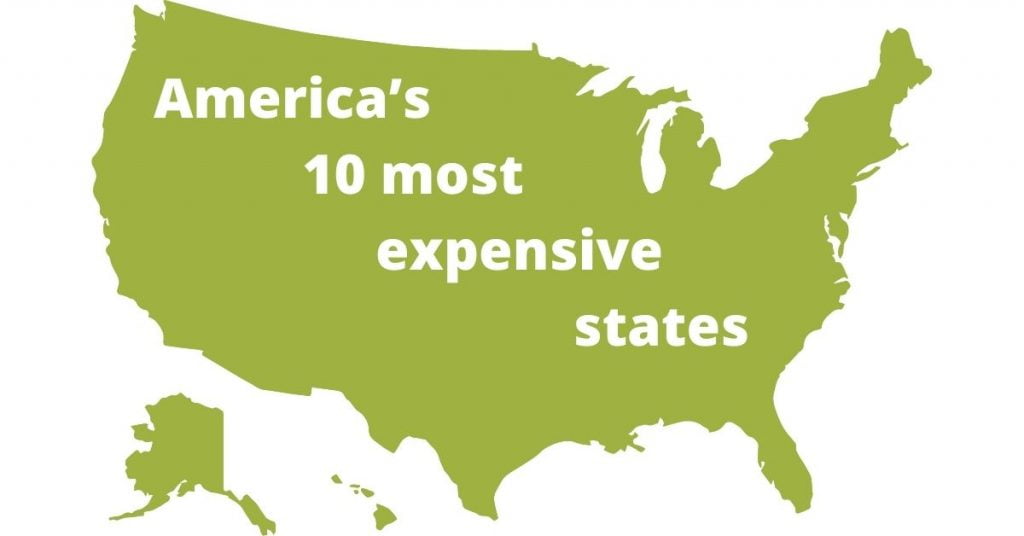
The United States is experiencing an unprecedented level of inflation not seen in decades, owing to a variety of factors including labor shortages, supply chain disruptions, and skyrocketing demand as the epidemic wanes. Labor shortages, production delays, and growing demand as the pandemic fades are all adding to price pressures. The situation is getting worse, making it increasingly tough for individuals and businesses to get by in the most costly states. Consumers and businesses alike are concerned about this issue.
The following are the ten most expensive states to live in last year. We compare where prices have been heading in the first half of this year with one year ago, according to the US Bureau of Labor Statistics, to see where they’re headed. Also listed are typical costs for certain items, based on the 2021 Average Cost of Living Index published by C2ER (Cost of Living Data Series). The index uses a base value for each category equal to the average across all urban areas.
All salaries listed are based on 2021earnings unless otherwise stated.
1. New Jersey
Salary: $75,278; Salary one year ago: $72,632; Adjusted increase: 4.1%
Item: A one-bedroom apartment in the cities is $2,100; Item: A two-bedroom apartment in the cities is $2,620; Index value for a one-bedroom in New Jersey is 138.9 and for a two-bedrooms, it’s 162.6
New Jersey has been ranked as America’s most expensive state to live in for three straight years now, and that doesn’t look likely to change anytime soon. Not only does the Garden State have some of America’s highest property taxes, but it also has some of the nation’s highest costs for energy and fuel as well as health care.
2. Hawaii
Salary: $73,580; Salary one year ago: $70,095; Adjusted increase: 4.8%
Item: A one-bedroom apartment in the cities is $1,850; Item: A two-bedroom apartment in the cities is $2,390; Index value for a one-bedroom in Hawaii is 217.3 and for a two-bedrooms, it’s 227.8
3. Massachusetts
Salary: $76,500; Salary one year ago: $72,097; Adjusted increase: 4.8%
Item: A one-bedroom apartment in the cities is $2,100; Item: A two-bedroom apartment in the cities is $2,760; Index value for a one-bedroom in Massachusetts is 144.8 and for a two-bedrooms, it’s 180.5
4. California
Salary: $75,780; Salary one year ago: $71,506; Adjusted increase: 5.7%
Item: A one-bedroom apartment in the cities is $2,120; Item: A two-bedroom apartment in the cities is $3,040; Index value for a one-bedroom in California is 148.4 and for a two-bedrooms, it’s 200.1
5. Alaska
Salary: $78,740; Salary one year ago: $75,214; Adjusted increase: 4.3%
Item: A one-bedroom apartment in the cities is $2,430; Item: A two-bedroom apartment in the cities is $3,070; Index value for a one-bedroom in Alaska is 182.8 and for a two-bedrooms, it’s 204.6
Alaska has been experiencing a real estate boom in recent years. The cost of living index for February 2019 places the price of a typical one-bedroom apartment in Anchorage at $2,430, while two bedrooms are typically priced at 4% more on average at $3,070. While owning property is not cheap in Alaska, this state continues to be highly desired for its unique offerings, ranging from the majestic landscape to the culture and history of indigenous people.
6. New Hampshire
Salary: $77,520; Salary one year ago: $73,074; Adjusted increase: 5.1%
Item: A one-bedroom apartment in the cities is $2,120; Item: A two-bedroom apartment in the cities is $2,800; Index value for a one-bedroom in New Hampshire is 167.7 and for a two-bedrooms, it’s 196.3
New Hampshire has been climbing up the rankings of America’s most expensive states to live in. Fuel costs appear to be responsible for much of that change, with the cost of gasoline jumping by 5.1% one year ago and electricity costs increasing by 3.4%.
7. Connecticut
Salary: $78,120; Salary one year ago: $74,006; Adjusted increase: 5.3%
Item: A one-bedroom apartment in the cities is $2,200; Item: A two-bedroom apartment in the cities is $2,880; Index value for a one-bedroom in Connecticut is 176.3 and for a two-bedrooms, it’s 192.0
Connecticut is not only considered one of America’s most expensive states to live in but also one of the worst states to commute in, with drivers in the state wasting an average of 12.7 hours per year stuck in traffic jams.
8. Vermont
Salary: $75,956; Salary one year ago: $72,599; Adjusted increase: 5.5%
Item: A one-bedroom apartment in the cities is $2,160; Item: A two-bedroom apartment in the cities is $2,820; Index value for a one-bedroom in Vermont is 170.0 and for a two-bedrooms, it’s 200.7
Vermont has experienced an average home appreciation of 8.4% per year since 2012, according to Zillow, with median sale prices currently at $256,400. Vermont is considered one of the best states in America to enjoy a long lifespan and also has an incredibly low divorce rate.
9. New Jersey
Salary: $79,448; Salary one year ago: $75,036; Adjusted increase: 5.6%
Item: A one-bedroom apartment in the cities is $2,270; Item: A two-bedroom apartment in the cities is $3,090; Index value for a one-bedroom in New Jersey is 181.8 and for a two-bedrooms, it’s 210.5
New Jersey state minimum wage workers can expect to earn just $8.60 per hour, well below the federal minimum wage of $7.25 an hour. However, that hasn’t stopped residents from flocking to the state in droves looking for employment – New Jersey is one of America’s fastest-growing states by population.
10. Hawaii
Salary: $78,400; Salary one year ago: $74,216; Adjusted increase: 5.6%
Item: A one-bedroom apartment in the cities is $2,450; Item: A two-bedroom apartment in the cities is $3,140; Index value for a one-bedroom in Hawaii is 191.4 and for a two-bedrooms, it’s 216.8
The cost of living indices for Hawaii state shows that it’s more expensive than any other state to rent a home. Residents generally have higher purchasing power when they spend their money in Honolulu, though the median income is lower than in most parts of the United States.
